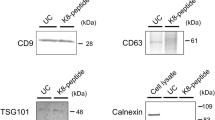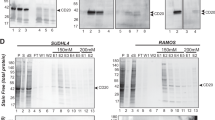Abstract
Seven-transmembrane segment, G protein-coupled receptors play central roles in a wide range of biological processes, but their characterization has been hindered by the difficulty of obtaining homogeneous preparations of native protein. We have created paramagnetic proteoliposomes containing pure and oriented CCR5, a seven-transmembrane segment protein that serves as the principal coreceptor for human immunodeficiency virus (HIV-1). The CCR5 proteoliposomes bind the HIV-1 gp120 envelope glycoprotein and conformation-dependent antibodies against CCR5. The binding of gp120 was enhanced by a soluble form of the other HIV-1 receptor, CD4, but did not require additional cellular proteins. Paramagnetic proteoliposomes are uniform in size, stable in a broad range of salt concentrations and pH, and can be used in FACS and competition assays typically applied to cells. Integral membrane proteins can be inserted in either orientation into the liposomal membrane. The magnetic properties of these proteoliposomes facilitate rapid buffer exchange useful in multiple applications. As an example, the CCR5-proteoliposomes were used to select CCR5-specific antibodies from a recombinant phage display library. Thus, paramagnetic proteoliposomes should be useful tools in the analysis of membrane protein interactions with extracellular and intracellular ligands, particularly in establishing screens for inhibitors.
This is a preview of subscription content, access via your institution
Access options
Subscribe to this journal
Receive 12 print issues and online access
$209.00 per year
only $17.42 per issue
Buy this article
- Purchase on Springer Link
- Instant access to full article PDF
Prices may be subject to local taxes which are calculated during checkout






Similar content being viewed by others
References
Drews, J. Genomic sciences and the medicine of tomorrow. Nat. Biotechnol. 11, 1516–1518 (1996)
Horn, F. et al. GPCRDB: an information system for G protein-coupled receptors. Nucleic Acids Res. 26, 275–279 (1998).
Stadel, J.M., Wilson, S. & Bergsma, D.J. Orphan G protein-coupled receptors: a neglected opportunity for pioneer drug discovery. Trends Pharmacol. Sci. 18, 430–437 (1997).
Wilson, S. et al. Orphan G-protein-coupled receptors: the next generation of drug targets? Br. J. Pharmacol. 125, 1387–1392 (1998).
Watson, S. & Arkinstall, S. The G-protein linked receptor-facts book. (Academic Press, London; 1994).
Wess, J. G-protein-coupled receptors: molecular mechanisms involved in receptor activation and selectivity of G-protein recognition. FASEB J. 11, 346–354 (1997).
Lefkowitz, R.J. G protein-coupled receptors and receptor kinases: from molecular biology to potential therapeutic applications. Nat. Biotechnol. 14, 283–286 (1996).
Tate, C.G. & Grisshammer, R. Heterologous expression of G-protein-coupled receptors. Trends Biotechnol. 14, 426–30 (1996).
Ji, T.H., Grossmann, M. & Ji, I. G protein-coupled receptors. I. Diversity of receptor–ligand interactions. J. Biol. Chem. 273, 17299–17302 (1998).
Gether, U. & Kobilka, B.K. G protein-coupled receptors. II. Mechanism of agonist activation. J. Biol. Chem. 273, 17979–17982 (1998).
Mellentin-Michelotti, J. et al. Determination of ligand binding affinities for endogenous seven-transmembrane receptors using fluorometric microvolume assay technology. Anal. Biochem. 272, 182–190 (1999).
Kell, D. Screensavers: trends in high-throughput analysis. Trends Biotechnol. 17, 89–91 (1999).
Littman, D.R. Chemokine receptors: keys to AIDS pathogenesis? Cell 93, 677–680 (1998).
Wyatt, R. & Sodroski, J.G. The HIV-1 envelope glycoproteins: fusogens, antigens and immunogens. Science 280, 1884–1888 (1998).
Wu, L. et al. CD-4 induced interaction of primary HIV-1 gp120 glycoproteins with the chemokine receptor CCR-5. Nature 384, 179–83 (1996).
Trkola, A. et al. CD4-dependent, antibody-sensitive interactions between HIV-1 and its co-receptor CCR-5. Nature 384, 184–187 (1996).
Alkhatib, G. et al. CC CKR5: a RANTES, MIP-1alpha, MIP-1beta receptor as a fusion cofactor for macrophage-tropic HIV-1. Science 272, 1955–1958 (1996).
Choe, H. et al. The beta-chemokine receptors CCR3 and CCR5 facilitate infection by primary HIV-1 isolates. Cell 85, 1135–1148 (1996).
Deng, H. et al. Identification of a major co-receptor for primary isolates of HIV-1. Nature 381, 661–666 (1996).
Doranz, B.J. et al. A dual-tropic primary HIV-1 isolate that uses fusin and the beta-chemokine receptors CKR-5, CKR-3, and CKR-2b as fusion cofactors. Cell 85, 1149–1158 (1996).
Dragic, T. et al. HIV-1 entry into CD4+ cells is mediated by the chemokine receptor CC-CKR-5. Nature 381, 667–673 (1996).
Samson, M. et al. Resistance to HIV-1 infection in Caucasian individuals bearing mutant alleles of the CCR-5 chemokine receptor gene. Nature 382, 722–725 (1996).
Liu, R. et al. Homozygous defect in HIV-1 coreceptor accounts for resistance of some multiply-exposed individuals to HIV-1 infection. Cell 86, 367–377 (1996).
Mirzabekov, T. et al. Enhanced expression, native purification, and characterization of CCR5, a principal HIV-1 coreceptor. J. Biol. Chem. 274, 28745–28750 (1999).
Wu, L. et al. Interaction of chemokine receptor CCR5 with its ligands: multiple domains for HIV-1 gp120 binding and a single domain for chemokine binding. J. Exp. Med. 186, 1373–1381 (1997).
Lee, B. et al. Epitope mapping of CCR5 reveals multiple conformational states and distinct but overlapping structures involved in chemokine and coreceptor function. J. Biol. Chem. 274, 9617–9626 (1999).
Tanaka, Y. et al. T-cell adhesion induced by proteoglycan-immobilized cytokine MIP-1 beta. Nature 361, 79–82 (1993).
Webb, L.M., Ehrengruber, M.U., Clark-Lewis, I., Baggiolini, M. & Rot, A. Binding to heparan sulfate or heparin enhances neutrophil responses to interleukin 8. Proc. Natl. Acad. Sci. USA 90, 7158–7162 (1993).
Luster, A.D., Greenberg, S.M. & Leder, P. The IP-10 chemokine binds to a specific cell surface heparan sulfate site shared with platelet factor 4 and inhibits endothelial cell proliferation. J. Exp. Med. 182, 219–231 (1995).
Zeng, F.Y. & Wess, J. Identification and molecular characterization of m3 muscarinic receptor dimers. J. Biol. Chem. 274, 19487–19497 (1999).
Salamon, Z., Wang, Y., Brown, M.F., Macleod, H.A. & Tollin, G. Conformational changes in rhodopsin probed by surface plasmon resonance spectroscopy. Biochemistry 33, 13706–11 (1994).
Salamon, Z., Wang, Y., Soulages, J.L., Brown, M.F. & Tollin, G. Surface plasmon resonance spectroscopy studies of membrane proteins: transducin binding and activation by rhodopsin monitored in thin membrane films. Biophys. J. 71, 283–294 (1996).
Bieri, C., Ernst, O.P., Heyse, S., Hofmann, K.P. & Vogel, H. Micropatternal immobilization of G protein-coupled receptor and direct detection of G protein activation. Nat. Biotechnol. 17, 1105–1108 (1999).
Molday, R.S. & MacKenzie, D. Monoclonal antibodies to rhodopsin: characterization, cross-reactivity, and application as structural probes. Biochemistry 22, 653–660 (1983).
Folch, J., Lees, M. & Sloan-Stanley, G.H. A simple method for isolation and purification of total lipids from animal tissue. J. Biol. Chem. 226, 497–509 (1957).
Wiener, M.C. & White, S.H. Structure of a fluid dioleoylphosphatidylcholine bilayer determined by joint refinement of x-ray and neutron diffraction data. III. Complete structure. Biophys. J. 61, 437–447 (1992).
Acknowledgements
We thank Ms. Sheri Farnum and Ms. Yvette McLaughlin for manuscript preparation, Ms. Minou Modabber for artwork, and Ms. Maris Handley for assistance with confocal microscopy. We acknowledge the National Cell Culture Center for supplying the 1D4 antibody. We thank Dr. R. Wyatt, Dr. J. Rhodes, and P. Kolchinsky for providing plasmids and for helpful discussions. This work was supported by grants (AI 41851 and GM 56550) from the National Institutes of Health, by a Center for AIDS Research grant, and by the G. Harold and Leila Mathers Foundation, the Friends 10, William F. McCarty Cooper, and Douglas and Judith Krupp.
Author information
Authors and Affiliations
Corresponding author
Rights and permissions
About this article
Cite this article
Mirzabekov, T., Kontos, H., Farzan, M. et al. Paramagnetic proteoliposomes containing a pure, native, and oriented seven-transmembrane segment protein, CCR5. Nat Biotechnol 18, 649–654 (2000). https://doi.org/10.1038/76501
Received:
Accepted:
Issue Date:
DOI: https://doi.org/10.1038/76501
This article is cited by
-
The rapid “teabag” method for high-end purification of membrane proteins
Scientific Reports (2020)
-
Therapeutic Monoclonal Antibodies to Complex Membrane Protein Targets: Antigen Generation and Antibody Discovery Strategies
BioDrugs (2018)
-
Engineering therapeutic antibodies targeting G-protein–coupled receptors
Experimental & Molecular Medicine (2016)
-
Regression of established renal cell carcinoma in nude mice using lentivirus-transduced human T cells expressing a human anti-CAIX chimeric antigen receptor
Molecular Therapy - Oncolytics (2014)
-
Selection of Potential Therapeutic Human Single-Chain Fv Antibodies against Cholecystokinin-B/Gastrin Receptor by Phage Display Technology
BioDrugs (2013)



